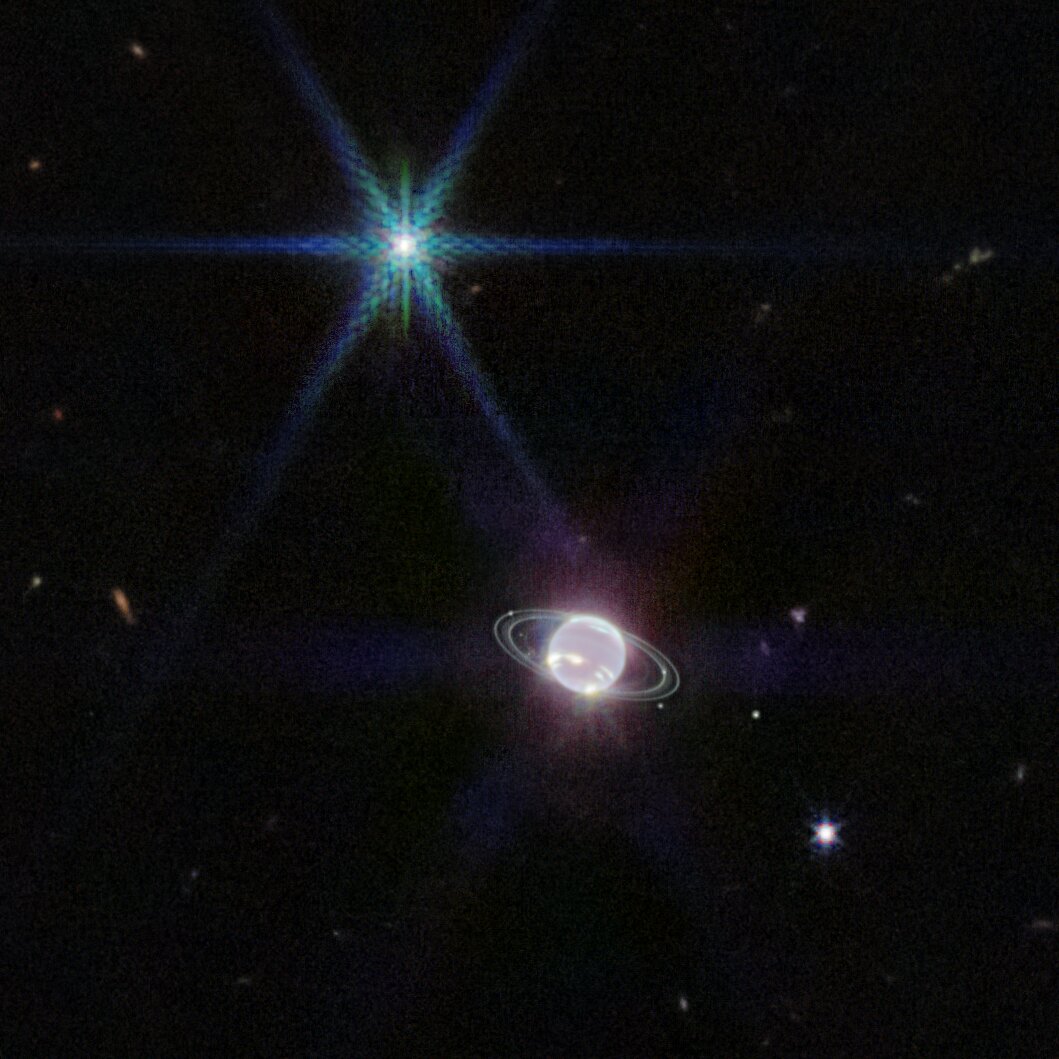What do we see in Webb’s latest image of the ice giant Neptune? Webb captured seven of Neptune’s 14 known moons: Galatea, Naiad, Thalassa, Despina, Proteus, Larissa, and Triton. Neptune’s large and unusual moon, Triton, dominates this Webb portrait of Neptune as a very bright point of light with the characteristic diffraction peaks seen in many of Webb’s images. Credit: NASA, ESA, CSA, STScI
NASA’s James Webb Space Telescope demonstrates its capabilities closer to home with its first image of Neptune. Not only has Webb captured the clearest view of this distant planet’s rings in more than 30 years, his cameras show the ice giant in a whole new light.
Most striking in Webb’s new image is the sharp view of the planet’s rings – some of which have not been spotted since NASA’s Voyager 2 became the first spacecraft to spot Neptune during its flyby in 1989. In addition to several bright, narrow rings, Webb’s image clearly shows Neptune’s fainter dust bands.
“It’s been three decades since we last saw these faint, dusty rings, and this is the first time we’ve seen them in the infrared,” notes Heidi Hammel, Neptune systems expert and interdisciplinary scientist for Webb. Webb’s extremely stable and precise image quality makes it possible to detect these very faint rings so close to Neptune.
Neptune has fascinated researchers since its discovery in 1846. Located 30 times farther from the Sun than Earth, Neptune orbits in the remote, dark region of the outer Solar System. At this extreme distance, the Sun is so small and faint that noon on Neptune resembles a dim twilight on Earth.
This planet is called an ice giant because of the chemical composition of its interior. Compared to the gas giants Jupiter and Saturn, Neptune is much richer in elements heavier than hydrogen and helium. This is readily apparent in Neptune’s characteristic blue appearance in Hubble Space Telescope images at visible wavelengths, caused by small amounts of gaseous methane.

Credit: NASA, ESA, CSA, STScI
Webb’s near-infrared camera (NIRCam) images objects in the near-infrared range of 0.6 to 5 microns, so Neptune does not appear blue to Webb. In fact, the methane gas absorbs red and infrared light so strongly that the planet is quite dark at these near-infrared wavelengths, except where clouds are present at high altitudes. Such methane ice clouds appear as bright streaks and patches that reflect sunlight before it is absorbed by the methane gas. Images from other observatories, including the Hubble Space Telescope and the WM-Keck Observatory, have charted these rapidly evolving cloud features over the years.
In a more subtle way, a thin bright line circling the planet’s equator could be a visual signature of the global atmospheric circulation driving Neptune’s winds and storms. The atmosphere sinks and warms at the equator and is therefore more luminous at infrared wavelengths than the surrounding, cooler gases.
Neptune’s 164-year orbit means its north pole, shown at the top of this image, isn’t just visible to astronomers, but the Webb images suggest intriguing brightness in the area. A previously known vortex at the South Pole is evident in Webb’s view, but for the first time Webb has visualized a continuous band of high-latitude clouds around it.
Webb also captured seven of Neptune’s 14 known moons. This Webb portrait of Neptune is dominated by a very bright point of light that exhibits the characteristic diffraction peaks seen in many of Webb’s images, but this is not a star. Rather, this is Neptune’s large and unusual moon, Triton.
Covered in a frozen sheen of condensed nitrogen, Triton reflects an average of 70% of the sunlight that hits it. In this image, it far outshines Neptune as the planet’s atmosphere is obscured by methane absorption at these near-infrared wavelengths. Triton orbits Neptune in an unusual backward (retrograde) orbit, leading astronomers to suspect that this moon was originally a Kuiper Belt object gravitationally captured by Neptune. Further Webb studies of Triton and Neptune are planned for the coming year.
Which planet has the most moons? Moons of Saturn, Venus and Jupiter explained
Provided by NASA’s Goddard Space Flight Center
Citation: New Webb image captures the clearest view of Neptune’s rings in decades (2022, September 21) retrieved September 21, 2022 from https://phys.org/news/2022-09-webb-image-captures- clearest-view.html
This document is protected by copyright. Except for fair trade for the purpose of private study or research, no part may be reproduced without written permission. The content is for informational purposes only.
#Webb #image #shows #clearest #view #Neptunes #rings #decades


Leave a Comment